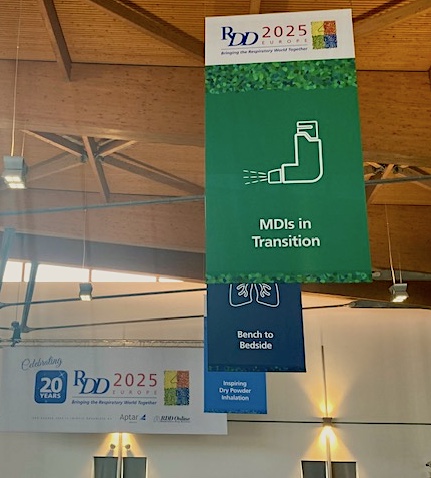In the Inhalation 5.0 session, De Backer followed up on his call for disruption of healthcare delivery by promoting the idea of bypassing the existing healthcare system altogether as one way to ensure that patients receive the treatment they need, describing the clinics for the treatment of chronic respiratory diseases that he has opened recently in several cities. The Medimprove clinics directly hire physicians who can use Fluidda’s technology as part of diagnosis and personalized treatment for patients and also also offer rehabilitation, which is the most effective treatment available, he said. Noting that rehabilitation is not offered to most patients in the US because it is not profitable, De Backer suggested, “You optimize for clinical outcome and not for billing and then I think you will see substantial improvement in the overall outcomes.”
The transition to LGWP propellants
The MDIs in Transition session featured a presentation by the FDA’s Elizabeth Bielski, appearing remotely via video link, updating her talk at RDD 2024 with a discussion of “FDA’s Current Perspectives on the Propellant Transition: Work Towards Global Harmonization.” In her talk, Bielski emphasized that she and her colleagues listened carefully to comments at the December 2024 FDA / CRCG workshop on “Navigating the Transition to Low Global Warming Potential Propellants” and are updating data requirements as a result.
She also stressed that both new LGWP propellants, HFA-152a and HFO 1234ze, are considered novel excipients and therefore the agency is currently requiring data that may not be required later, after safety profiles have been well established. For example, Bielski suggested that in cases where there is good in vivo in vitro PK correlation between the old formulation and the new LGWP formulation, clinical endpoint studies may be avoided in the future.
In addition to reviewing the FDA’s current thinking on requirements for the transition, she emphasized the agency’s desire to work toward harmonization with other regulatory bodies, particularly the EMA. For now, she recommends early and frequent communication between sponsors and the FDA regarding requirements and reiterated the agency’s commitment to communicating with the industry, including participation at the upcoming ISAM meeting in Washington, DC.
Both HFA-152a manufacturer Orbia (Koura) and HFO-1234ze manufacturer Honeywell offered presentations designed to alleviate regulatory and other concerns about their propellants. Honeywell and Lupin, which recently announced that it would develop MDIs with HFO-1234ze, partnered to present a workshop on “Navigating the Global Regulatory Landscape Enabling the Sustainability Transition in the pMDI Space.” Also in the workshop session, Orbia’s discussed “Traversing the Technical Difficulties Associated with Maintaining a Consistent Medical Propellant Supply Throughout the low GWP Transition,” addressed concerns about potential supply issues.
In the MDIs in Transition session, Isaac Mohar of Gradient, who said that he has been working with Koura to establish the safety of HFA-152a for 10 years, presented a talk titled, “Safety Overview of Zephex 152a as a Low GWP Medical Propellant.” Mohar reports that a DMF for the propellant has been completed in China and is to be submitted soon in the US and Canada. Mohar emphasized that while 152a is considered flammable, it is very unlikely that it could be ignited during use of an MDI.



